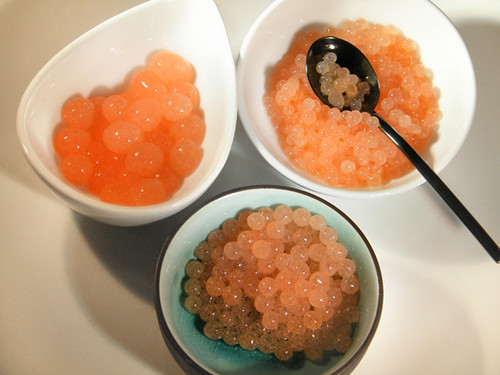For my chemistry project, my group is making fruit caviar (or what we like to call "juice balls"). They're super difficult to get just right since dissolving the sodium alginate takes a bit of work without the appropriate materials (mainly an immersion blender). But I highly recommend you try this recipe out. It's tons of fun and getting the sodium alginate, calcium chloride, and the other materials is relatively easy. (Here's a link to purchase the sodium alginate and calcium chloride. The other materials can be found on Amazon.)
Ingredients:
9 oz. Ruby Red Grapefruit Juice
18 oz. Cold Water
1 g Sodium Alginate
3 g Calcium Chloride
Digital Scale
Syringe (without the needle)
1 Large Bowl
2 Medium Bowls
Immersion Blender
Fine Mesh Strainer
Instructions:
1. Fill one of the medium sized bowls with about 4 inches of cold water. Set it aside since it will be for the final step in making the fruit caviar.
2. In the large bowl mix the sodium alginate with about half of the juice and blend until completely dissolved.
3. Mix in the remaining fruit juice.
4. Strain into empty medium bowl. (let it sit to remove any air bubbles)
5. In another medium bowl, dissolve the calcium chloride in the 18 oz. of cold water.
6. Fill a syringe with the sodium alginate mixture (It will be somewhat think and kind of globby.)
7. Gently discharge the sodium alginate mixture into the calcium chloride solution. (drop by drop)
8. After about a minute, gently remove the caviar and add to the cold water bath.
9. Wait a couple of minutes and then remove the caviar from the water bath into a serving dish or spoon.


Bis Morgen!
Note: Try other juices. It works for pretty much any kind of juice or even alcohol. Be aware that the proportions will be different for every juice (mainly those with higher acidity and high alcohol content).
No comments:
Post a Comment